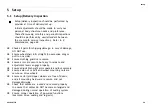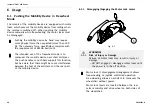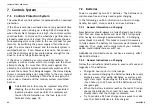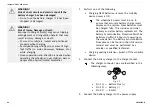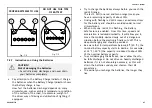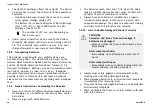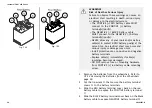
Invacare® TDX® SP2 Series
•
The depth of discharge affects the cycle life. The harder
a battery has to work, the shorter is its life expectancy.
Examples:
– One deep discharge stresses the same as 6 normal
cycles (green /orange display off).
– The battery life is about 300 cycles at 80% discharge
(first 7 LED off), or about 3000 cycles at 10%
discharge (one LED off).
The number of LED can vary depending on
the remote type.
•
Under normal operation, once a month the battery
should be discharged until all green and orange LED are
off. This should be done within one day. A 16 hour
charge afterwards is necessary as reconditioning.
7.2.8 Transporting Batteries
The batteries supplied with your mobility device are
not hazardous goods. This classification is based on the
German GGVS Hazardous Goods Road Transport Ordinances,
and the IATA/DGR Hazardous Goods Rail Transport / Air
Transport Ordinances. Batteries may be transported without
restrictions, whether by road, rail or by air. Individual
transport companies have, however, guidelines which can
possibly restrict or forbid certain transport procedures.
Please ask the transport company regarding each individual
case.
7.2.9 General Instructions on Handling the Batteries
•
Never mix and match different battery manufacturers or
technologies, or use batteries that do not have similar
date codes.
•
Never mix gel with AGM batteries.
•
The batteries reach their end of life when the drive
range is significantly smaller than usual. Contact your
provider or service technician for details.
•
Always have your batteries installed by a properly
trained mobility device technician or a person with
adequate knowledge. They have the necessary training
and tools to do the job safely and correctly.
7.2.10 How to Handle Damaged Batteries Correctly
CAUTION!
Corrosion and burns from acid leakage if
batteries are damaged
– Remove clothes that have been soiled by acid
immediately.
After contact with skin:
– Immediately wash affected area with lots of
water.
After contact with eyes:
– Immediately rinse eyes under running water for
several minutes; consult a physician.
•
Always wear safety goggles and appropriate safety
clothing when handling damaged batteries.
•
Place damaged batteries in an acid-resistant receptacle
immediately after removing them.
•
Only ever transport damaged batteries in an appropriate
acid-resistant receptacle.
•
Wash all objects that have come into contact with acid
with lots of water.
48
60101877-B
Summary of Contents for TDX SP2 series
Page 86: ...Notes...
Page 87: ...Notes...






